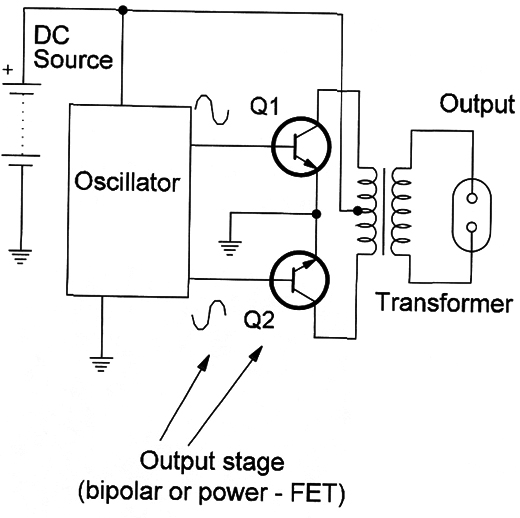Keep in mind when using an inverter that it is not possible to create energy. This means that all the power needed by the load must be generated by the batteries or cells. Batteries and cells are low-power energy sources, which means that the amount of power sourced by an inverter cantt be high, or under any circumstances, higher than the capabilities of the cells or battery.
As a general rule, inverters powered from cells or batteries are only used to power low-consumption appliances, such as large fluorescent lamps in emergency systems, signaling devices, and xenon beacons. Inverters powered from car batteries or other heavy-duty batteries can source energy to medium-power appliances like small TVs, electric razors, small fluorescent lamps, transmitters, laptop computers, small xenon beacons, and incandescent lamps.
How they work
A typical inverter is formed by a low-frequency oscillator running on the AC power-line frequency and a high-power output stage using transistors (bipolar, power FETs, or lGBTs) to drive a transformer, as shown in Figure 1.

The signal applied to the low-voltage winding of the transformer appears as an AC high voltage in the secondary winding. The quality of the transformer determines how much power can be transferred from the Iowvoltage to the high-voltage circuit, determining the efficiency of the converter. Values as high as 90 percent are common in commercial types, meaning that for each 10 watts of power drained from the battery, 9 watts are load and 1 watt is transformed into heat by the circuits.
Most of the heat is converted by the output transistor because they are mounted in large heat sinks. ln commercial types, the metallic box is used as a heat sink.
It is important to observe that in many types, the wave shape of the output voltage is not sinusoidal . The conversion made by circuits using pulses and the construction of the transformer can result in different wave shapes.
In the applications here, the wave shape is critical because it is important to see if the inverter is working as needed. For an electrician, the inverters are important because they are found in emergency lighting systems or powering devices that are normally powered from the AC power line.
The following are some important applications for inverters.
They can be used to power electric appliances from batteries and cells in emergency situations or in places where AC power is not available, such as cars, boats, and on camping trips.
lnverters for fluorescent lamps are used in emergency lighting systems. The batteries used in these systems are charged by AC power-line voltages.
They are used in no-break systems for computers, which supply energy for a computer if an AC power outage occurs.
Xenon beacons and car ignition systems use high voltages that can be generated by inverters. For beacons the AC power-line voltage is stepped up by an inverter, and for ignition systems the car battery voltage is stepped up to values as high as 600V.
Figure 1 shows an inverter that can be plugged into an automobile's Iighter outlet and used to power small appliances and other electronic devices by converting the 12V power from the battery of a car into 110-120V AC power.

Working with inverters
It is very important for a technician to know what kind of inverter is recommended for an application. Not only are inverters critical equipment, but also the powered circuits can be damaged if an incorrect choice is made. The following are main specifications an electrician must observe when working with inverters.
A. Output power
It is important to be sure that the inverter can supply enough power to the load. The power specification is given in watts (W). Take care with audio equipment where the output power doesn't reflect the consumed power; it can be given in a unit of watts, peak, or PMPO (instantaneous power peak).
B. Wave shape
The wave shape of many inverters isn't sinusoidal. This fact can be important in some applications. Lamps and heaters don't need a sinusoidal wave shape to be powered.
C. Performance
The higher the amount of energy converted, the better the inverter. Good inverters have a performance of 70 percent or more.
D. Isolation
The high voltages found in the output of inverters can cause severe shocks. Appropriate wires must be used to connect the loads if they are not plugged directly into an outlet, as in the case of fluorescent lamp inverters.
E. Battery placement
If not sealed, batteries used to power the inverter must be placed where the poisonous gases produced can be eliminated.
F. Wiring
Wiring to the battery can be done using wires based on the current drained by the inverter. A 100W inverter With an efficiency of 80 percent can draín a current as high as 12A from the battery. The wires must be able to handle this current.
Troubleshooting
The output transistor is the most fragile component in this type of circuit because it operates under limited conditions. When replacing these transistors, make sure that the type chosen supports the same voltage.
The suffix indicates, in many cases, the operational voltage. For example, a TlP32A supports less voltage across it than the TIP32B.




